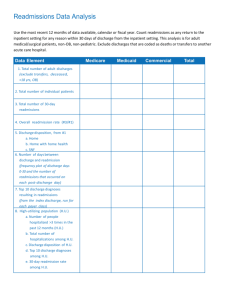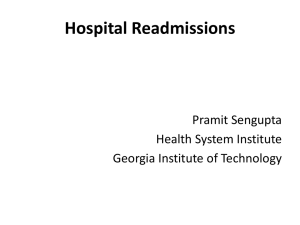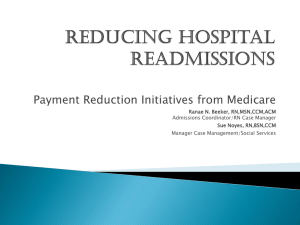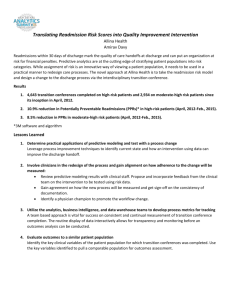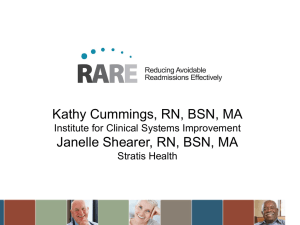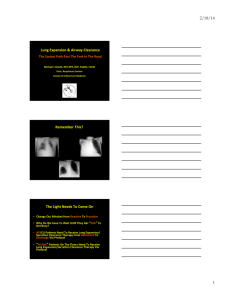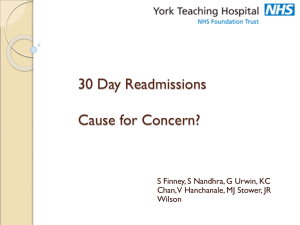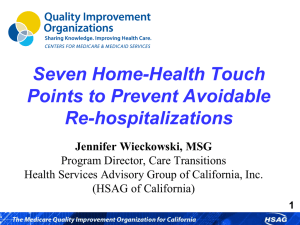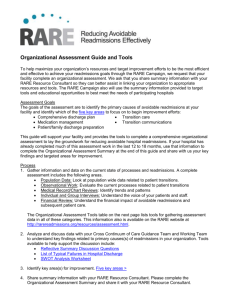Healthcare Informatics Executive Summit 2012
advertisement
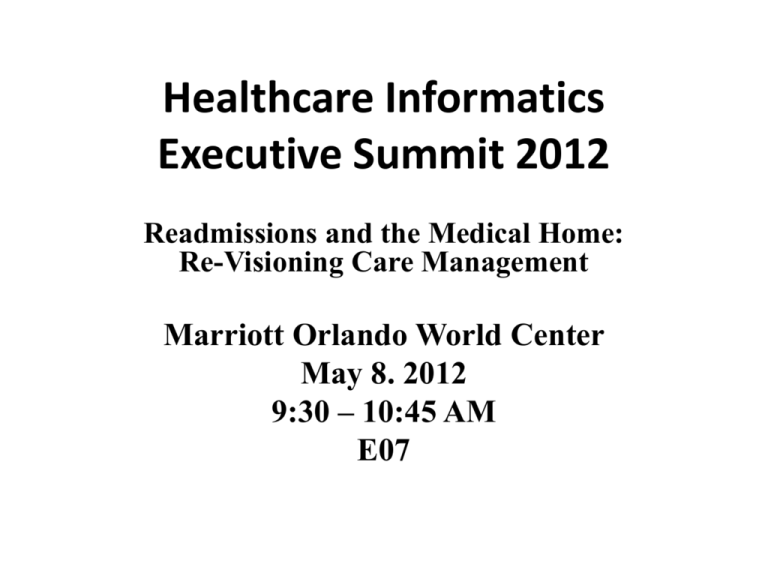
Healthcare Informatics Executive Summit 2012 Readmissions and the Medical Home: Re-Visioning Care Management Marriott Orlando World Center May 8. 2012 9:30 – 10:45 AM E07 James L. Holly, MD CEO, SETMA, LLP Adjunct Professor Department of Family and Community Medicine University of Texas Health Science Center San Antonio, School of Medicine ACO Integrator: Exercise in Accountability The following discussion addresses how SETMA which participates in Medicare Advantage capitation, Patient-Centered Medical Home and in a federally qualified ACO, addresses one of the biggest challenges to success which is decreasing preventable readmissions to the hospital. Preventable Hospital Readmissions Public Policy • Care planning that begins with an assessment at admission — nurse care managers representing the insurer, the hospital, and the primary providers must collaborate. • Clear discharge instructions with particular attention to medication management — incorporating the input of the inpatient and outpatient pharmacist has proven effective. • Discharge to a proper setting of care — Hospital case management screenings should determine rehab/skilled nursing requirements before discharge to outpatient care. 4 Preventable Hospital Readmissions Public Policy • Timely physician follow-up visits — with primary care provider and appropriate specialists; preferably the appointment should be scheduled prior to discharge. • Appropriate use of palliative care and end-of-life planning should be built into the hospital discharge process. Palliative specialists and hospice expertise need to be integrated components of post-hospital planning. 5 SETMA’s Hospital Discharges Total Discharges • • • • • 2009 2010 2011 2012 * Total – – – – – Readmission Rate (Days) 30 60 2995 3001 4194 946 11055 -16.5% 17.4% --- -21.9% 24.6% --- *Jan, Feb 2012 6 CMS Fee For Service Medicare Study – Medical Homes vs. Benchmarks 7 Care Transition Audit • Quarterly and annually, SETMA audits each provider’s performance on these measures and publishes that audit on our website under “Public Reporting,” along with over 200 other quality metrics which we track routinely. • The following is the care transition audit results by provider name for 2011. 8 Care Transition Audit 9 Care Transition Audit 10 Hospital Care Summary and Post Hospital Plan of Care and Treatment Plan 11 Hospital Care Summary and Post Hospital Plan of Care and Treatment Plan Hospital Care Summary completed at the time the patient is discharged from the hospital: Year Completion (%) 2010 98.8 2011 97.7 2012* 92.1 Cumulative 97.7 * January 1, 2010 to date 12 Hospital Readmission Reporting 13 Hospital Readmission Reporting 14 Hospital Readmission Reporting 15 Hospital Readmission Reporting 16 Hospital Readmission Strategies 17 All Readmissions Are Not Preventable “Critical to the analysis of readmissions is appropriateness. Some readmissions may be unavoidable. Other readmissions may be avoidable, but nevertheless occur, due to a lack of follow-up care coordination or some other problem. Obtaining a readmissions rate of zero is not feasible and may even indicate poor quality care, as many readmissions are medically appropriate due to an unavoidable change in condition or a new condition. For example, physicians may provide patient centered care by discussing early discharge with patients, with the mutual understanding that readmission may be necessary.” 18 Risk of Readmissions Recent studies continue to suggest the risk of readmission can be quantified based on a patient's risk factors and therefore are an important tool in establishing evidence-based best practices. 19 Risk of Readmissions • The Journal of Hospital Medicine recently published a pair of studies in which researchers analyzed data from California and Austria to determine the risk factors of hospital readmission. • Medicare • Medicaid • Black Race • Inpatient use of narcotics • Inpatient use of corticosteroids • Cancer with and without metastasis • Renal Failure • Congestive Heart Failure • Weight loss 20 Risk of Readmissions 21 Managing High Risk Patients When a person is identified as a high risk for readmissions, SETMA’s Department of Care Coordination is alerted. The following ten steps are then instituted: 1. Hospital Care Summary and Post Hospital Plan of Care and Treatment Plan is given to patient, care giver or family member. 2. The post hospital, care coaching call, which is done the day after discharge, goes to the top of the queue for the call – made the day after discharge by SETMA’s Care Coordination Department. It is a 12-30 minute call. 22 Managing High Risk Patients 3. Medication reconciliation is done at the time of discharge, is repeated in the care coordination call the day after discharge and is repeated at the follow-up visit in the clinic. 4. MSW makes a home visit for need evaluation, including barriers and social needs for those who are socially isolated. 5. A clinic follow-up visit within three days for those at high risk for readmission. 23 Managing High Risk Patients 6. A second care coordination call in four days. 7. Plan of care and treatment plan discussed with patient, family and/or care giver at EVERY visit and a written copy with the patient’s reconciled medication list, follow-up instructions, state of health, and how to access further care needs. 8. MSW documents barriers to care and care coordination department designs a solution for each. 24 Managing High Risk Patients 9. The patient’s end of life choices and code status are discussed and when appropriate hospice is recommended. 10. Referral to disease management is done when appropriate, along with telehealth monitoring measures. 25 Managing High Risk Patients • Currently, SETMA’s determination of whether patients are high risk for readmissions is intuitively determined, i.e., at discharged based on experience and judgment, a patient is designated as potentially high risk for readmission. SETMA is designing a “predictive model” for identifying patients at high risk for readmissions and instituting the above plan for interdicting a readmission. This is an attempt to quantify the most effective opportunities for decreasing preventable readmissions. 26 Managing High Risk Patients • There is a significant body of science associated with “predictive modeling.” It is clear that tradition models of care delivery will not “work” in a sustainable program for decreasing readmissions. Traditional disease management will not result in changing the patterns of care. In a January/February, 2012 Professional Care Management Journal article, the following abstract addressed changes needed to affect a decrease in preventable readmissions: 27 Managing High Risk Patients • “Purpose/Objectives: The move to the Accountable Care Organization model of care calls for broad-sweeping structural, operational, and cultural changes in our health care systems. The use of predictive modeling as part of the discharge process is used as a way to highlight just one of the common processes that will need to be transformed to maximize reimbursement under the Accountable Care Organization model. The purpose of this article is to summarize what has been learned about predictive modeling from the population health management industry perspective, to discuss how that knowledge might be applied to discharge planning in the Accountable Care Organization model of patient care, and then to outline how the Accountable Care Organization environment presents various challenges, opportunities, and implications for the case management role.” 28 Managing High Risk Patients • “Findings/Conclusions: The development of predictive models to identify patients at risk for readmission and can positively impact the discharge planning process by lowering readmission rates. Examples of the structural, operational, cultural, and case management role changes necessary to maximize the benefits of an Accountable Care Organization are critical.” • “Implications for Case Management Practice: There is a growing need for advanced practice nurses to fill the leadership, resource management, analytical, informatics-based, and organizational development roles that are sorely needed to advance the Accountable Care Organization model of care. Case managers are well-positioned to lend their expertise to the development efforts, but they will need to be educationally prepared for the many advanced practice roles that will emerge as our nation evolves this new system of health care delivery.” 29 National Priorities Partnership Focus in care coordination by NPP are the links between: • Care Transitions - …continually strive to improve care by … considering feedback from all patients and their families… regarding coordination of their care during transitions between healthcare systems and services, and…communities. • Preventable Readmissions - …work collaboratively with patients to reduce preventable 30-day readmission rates. 30 Hospital Care Summary • Once the Care Transition issues are completed, The Hospital Care-Summary-and-Post- Hospital-Plan-of Care-and Treatment-Plan document is generated and printed. It is given to the patient and/or to the patient’s family and to the hospital. 31 An Integrator’s Tool: The Baton The following picture is a portrayal of the “plan of care and treatment plan” which is like the “baton” in a relay race. 32 An Integrator’s Tool: The Baton “The Baton” is the instrument through which responsibility for a patient’s health care is transferred to the patient or family. Framed copies of this picture hang in the public areas of all SETMA clinics and a poster of it hangs in every examination room. The poster declares: Firmly in the provider’s hand --The baton -- the care and treatment plan Must be confidently and securely grasped by the patient, If change is to make a difference 8,760 hours a year. • 33 An Integrator’s Tool: The Baton The poster illustrates: 1. That the healthcare-team relationship, which exists between the patient and the healthcare provider, is key to the success of the outcome of quality healthcare. 2. That the plan of care and treatment plan, the “baton,” is the engine through which the knowledge and power of the healthcare team is transmitted and sustained. 3. That the means of transfer of the “baton,” which has been developed by the healthcare team, is a coordinated effort between the provider and the patient. 34 An Integrator’s Tool: The Baton 4. That typically the healthcare provider knows and understands the patient’s healthcare plan of care and the treatment plan, but without its transfer to the patient, the provider’s knowledge is useless to the patient. 5. That the imperative for the plan – the “baton” – is that it must be transferred from the provider to the patient, if change in the life of the patient is going to make a difference in the patient’s health. 35 An Integrator’s Tool: The Baton 6. That this transfer requires that the patient “grasps” the “baton,” i.e., that the patient accepts, receives, understands and comprehends the plan, and that the patient is equipped and empowered to carry out the plan successfully. 7. That the patient knows that of the 8,760 hours in the year, he/she will be responsible for “carrying the baton,” longer and better than any other member of the healthcare team. 36 An Integrator’s Tool: The Baton After the care transition audit is completed and the document is generated, the provider completes the HospitalFollow-up-Call document: 37 An Integrator’s Tool: The Baton • During that preparation of the “baton,” the provider checks off the questions which are to be asked the patient in the follow-up call. • The call order is sent to the Care Coordination Department electronically. The day following discharge, the patient is called. • The call is the beginning of the “coaching” of the patient to help make them successful in the transition from the inpatient setting. 38 Preventing Hospital Readmission 1. The problem of readmissions will not be solved by more care: more medicines, more tests, more visits, etc. 2. The problem will be solved by redirecting the patient’s attention for a safety net away from the emergency department. 3. The problem will be solved by our having more proactive contact with the patient. 39 Preventing Hospital Readmission 4. The problem will be solved by more contact with the patient and/or care giver in the home: home health, social worker, provider house calls. 5. The problem will be solved by the patient and/or care giver having more contact electronically (telephone, e-mail, web portal, cell phone) with the patient giving immediate if not instantaneous access. 40
